Woodstock Road: how a visionary scheme became paint on a pavement
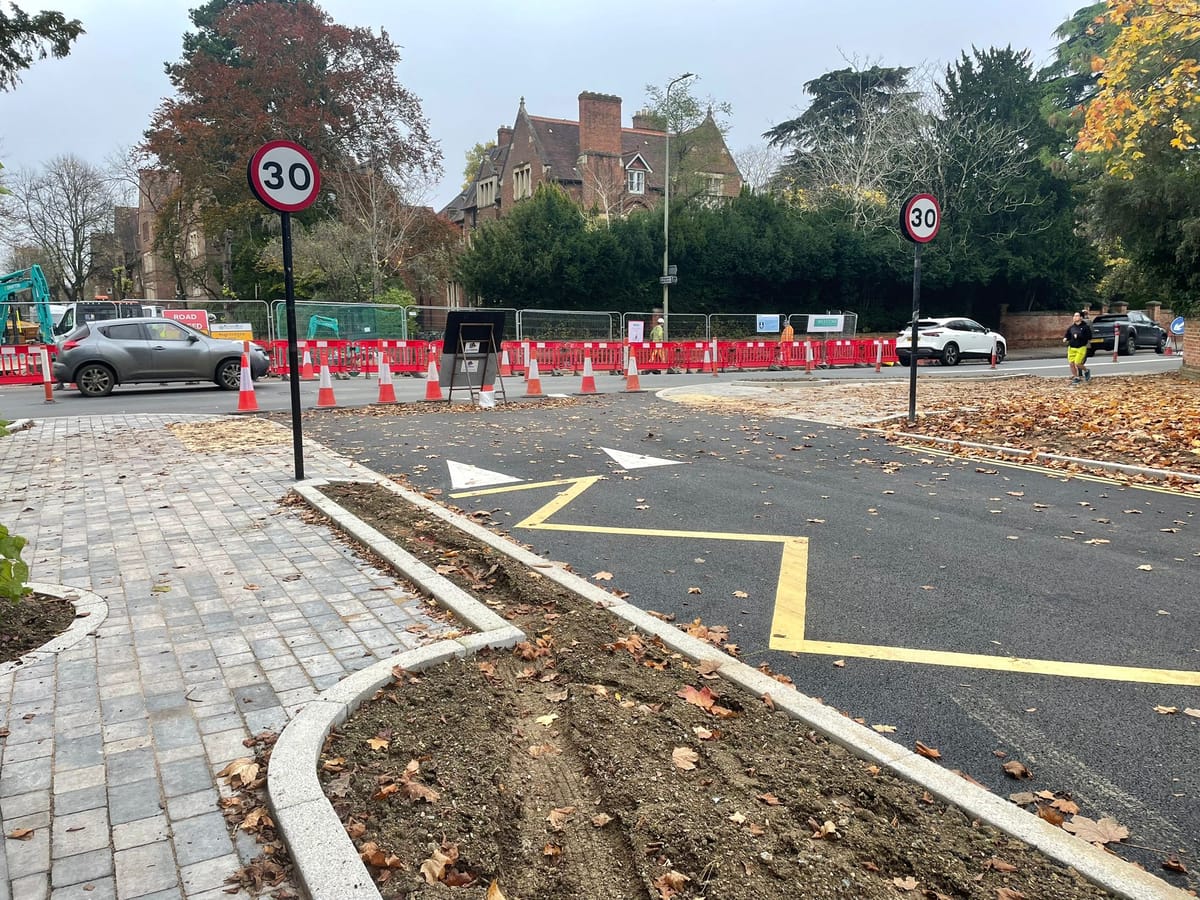
Woodstock Road has a traffic problem.
Your Clarion writer experienced this first-hand recently. It was 3.15pm, school run time, and traffic was moving desperately slowly – we would estimate an average of 5mph. It was stop-start all the way from First Turn to Squitchey Lane, where Team Clarion decided to throw caution to the wind and go down the bus lane instead.
But that was fine, because we were on a bike. The congestion was not in the general traffic lanes, which were flowing freely, but on the narrow, shared-use cycle path – as a peloton of happy junior cyclists from Wolvercote Primary School made their weaving way home.
Oxford’s cycle infrastructure is creaking. Improvements to quiet routes, from North Oxford’s resurfaced canal towpath to East Oxford’s Low Traffic Neighbourhoods, have only pointed up the lack of provision on main roads and at crucial junctions. A 20% increase in short-distance cycling within the LTNs has not been matched by more cross-Oxford trips, as riders are still funnelled across the dangerous Plain roundabout and up the chaotic High Street. ‘Vision Zero’, of eliminating deaths and serious injuries on the county’s roads, looks ever more distant in the week that a young cyclist was airlifted to hospital after a collision in Summertown.
Oxfordshire County Council’s plans for Woodstock Road were the first genuine attempt to address this. They would have been a step-change in cycling provision, with safe, protected cycle tracks to equal those now being installed in London, Cambridge and cities across the UK.
But that scheme was cancelled in favour of a set of crossing improvements and a short extension to the existing pavement cycle track – one that campaign group Cyclox says it “strongly objects” to, and that even council officers admit “falls short of long-term aspirations and design guidance”. What went wrong?
Vision
In 2021, Oxfordshire County Council proudly announced “We have secured £12.5m for improvement work on Woodstock Road between Wolvercote Roundabout and St. Giles to improve walking and cycling facilities, and public transport for those who rely on this busy corridor for work and leisure.”
The plans, drawn up in consultation with local residents, cycling and walking groups, envisaged a protected cycleway in each direction for almost the full length of the road. Pedestrians would no longer have to share space with cyclists. Funding would come from the Housing & Growth Deal, a Government initiative to fund the infrastructure needed for new houses – such as those in the Oxford North development.
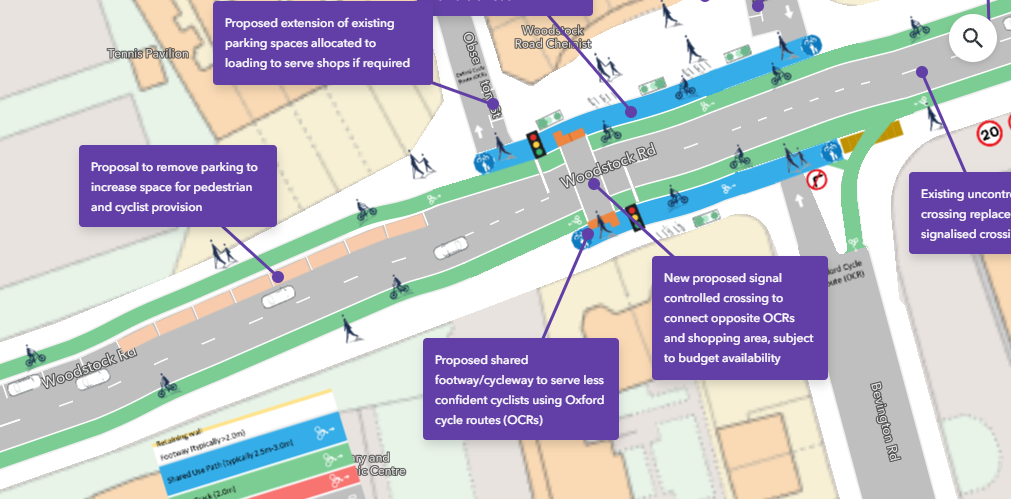
No dedicated cycling space of this size had been constructed in Oxford for 50 years (Marston Ferry Road, 1971). Alison Hill, then chair of Cyclox, said the scheme promised “the first truly safe infrastructure along any of Oxford’s major roads.”
For the first time in Oxford, the plans had been drawn up with a ‘co-production’ approach, where stakeholders (such as bus operators, cycling and walking groups, and the University of Oxford) were invited to feed into the plans at an early stage rather than simply commenting on a council-drawn design. They were also closely informed by the national Government’s cycling design guidelines, LTN 1/20, which sets a higher standard than that previously attained by Oxford’s on-road bike lanes.
Construction was planned to start in late 2022 and take 12 months. A similar scheme was to follow for Banbury Road (“funding has also been secured for improvements along the Banbury Road corridor… design proposals are expected to be consulted upon in early 2022”).
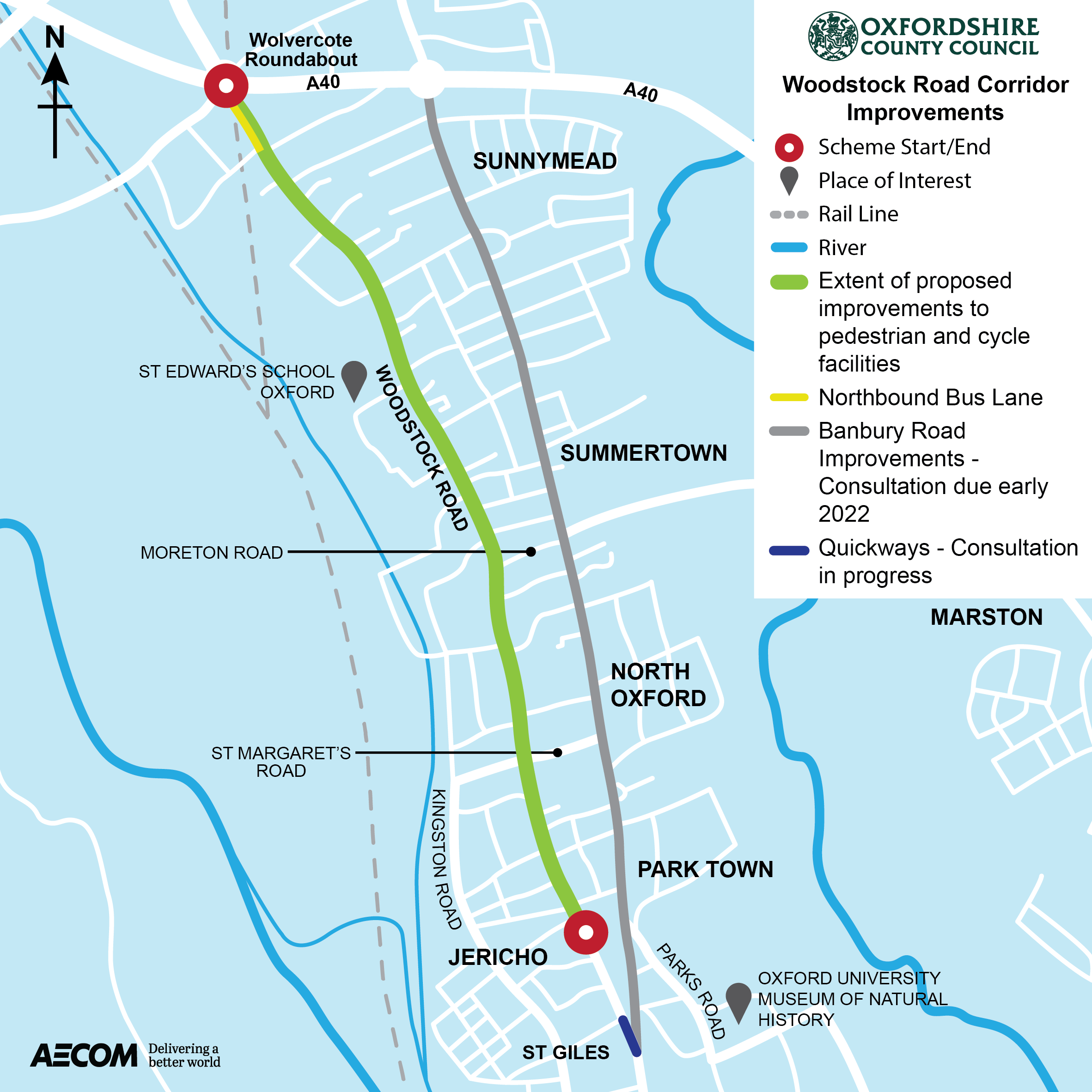
Reality
Construction inflation, rampant in recent years, was accelerated by Covid. Notes accompanying the original plans warned that the £12.5m budget was fixed:
If the actual cost is higher than the allocated budget… the project may need to be delivered in phases or some upgrades may not be accommodated.
This budgetary rigour, it transpired, didn’t apply to car- and bus-centric projects.
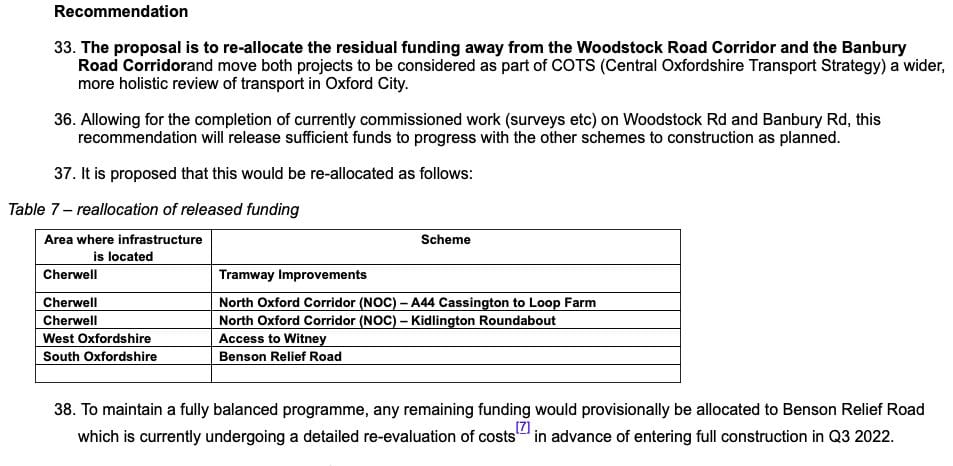
As inflation made Oxfordshire’s package of housing-led road improvements unaffordable, it was the cycling schemes on Woodstock Road and Banbury Road that got the chop. A council brief proposed that their funding would be “reallocated” to schemes around Banbury station, the A40 near Witney, the Benson Relief Road, the A44 at Yarnton, and Kidlington Roundabout, which were going over budget. All these were primarily bus or car schemes, though with cycling elements. Unlike Woodstock Road, they would be allowed to continue unabated even “if the actual cost is higher than the allocated budget”.
Housing-led funding is opaque and makes its way through the Future Oxfordshire Partnership, a committee grouping all Oxfordshire’s councils. Nonetheless Clarion reading of OCC and Future Oxfordshire Partnership documents suggests that the proposal to drop the Woodstock Road and Banbury Road schemes ultimately originated with OCC officers. Some officers fretted about the loss of a bus lane, although the original proposal had argued that “A greater proportion of cyclists using the proposed facility (as opposed to bus/vehicle lanes) is considered to help speed up buses along the corridor. ”
Councillors pushed back against the officers’ proposals. An Oxfordshire-wide scrutiny committee declined to endorse them. Speakers at an OCC Cabinet meeting called the move “very disappointing”.
But this wasn’t the end of the story.
“Targeted measures”
Later in 2022, a revised budget was produced with a line reinstated for Woodstock Road – but just £4m, less than a third of the original £12.5m. No designs were associated with this figure.
Then in June 2023, OCC confirmed it would not be bringing forward the original plans for a protected cycle track. Instead, it spoke of “targeted and localised measure to improve cycle and pedestrian facilities” – in other words, the existing narrow shared-use pavement, spurned by many cyclists due to the uneven surface and frequent road crossings.
Oxfordshire County Council says it has dropped plans for a protected, Dutch-style cycleway along Woodstock Road (pictured). Instead, it is suggesting only “an opportunity to consider some targeted and localised measures to improve cycle and pedestrian facilities in the area”. pic.twitter.com/tHICcnozUt
— Oxford Clarion (@OxfordClarion) June 20, 2023
These “targeted measures” were finally unveiled in a consultation in March 2024, with the budget further reduced to £3.2m. The consultation documents made no mention of the earlier proposals. Respondents were scathing of the lack of ambition, one saying “There is effectively nothing in these plans that benefits cyclists.” Campaign group Cyclox said “We strongly object to the new cycle lane – it is not design-compliant”, while the Lathbury Road Residents’ Association said “Shared-use cycle paths [will] not be used as poor priority/provision/prefer priority on the main carriageway.”
OCC conceded that the plans could be better.
Officers recognise that the proposal falls short of long-term aspirations and design guidance within publications like LTN 1/20. It is considered that a medium/long term solution more beneficial for pedestrians and people cycling could come forward in the future but that this would be dependent on potential road space reallocation that may be made possible if the trial traffic filters are successful and are made permanent at a future date.
What’s being built?
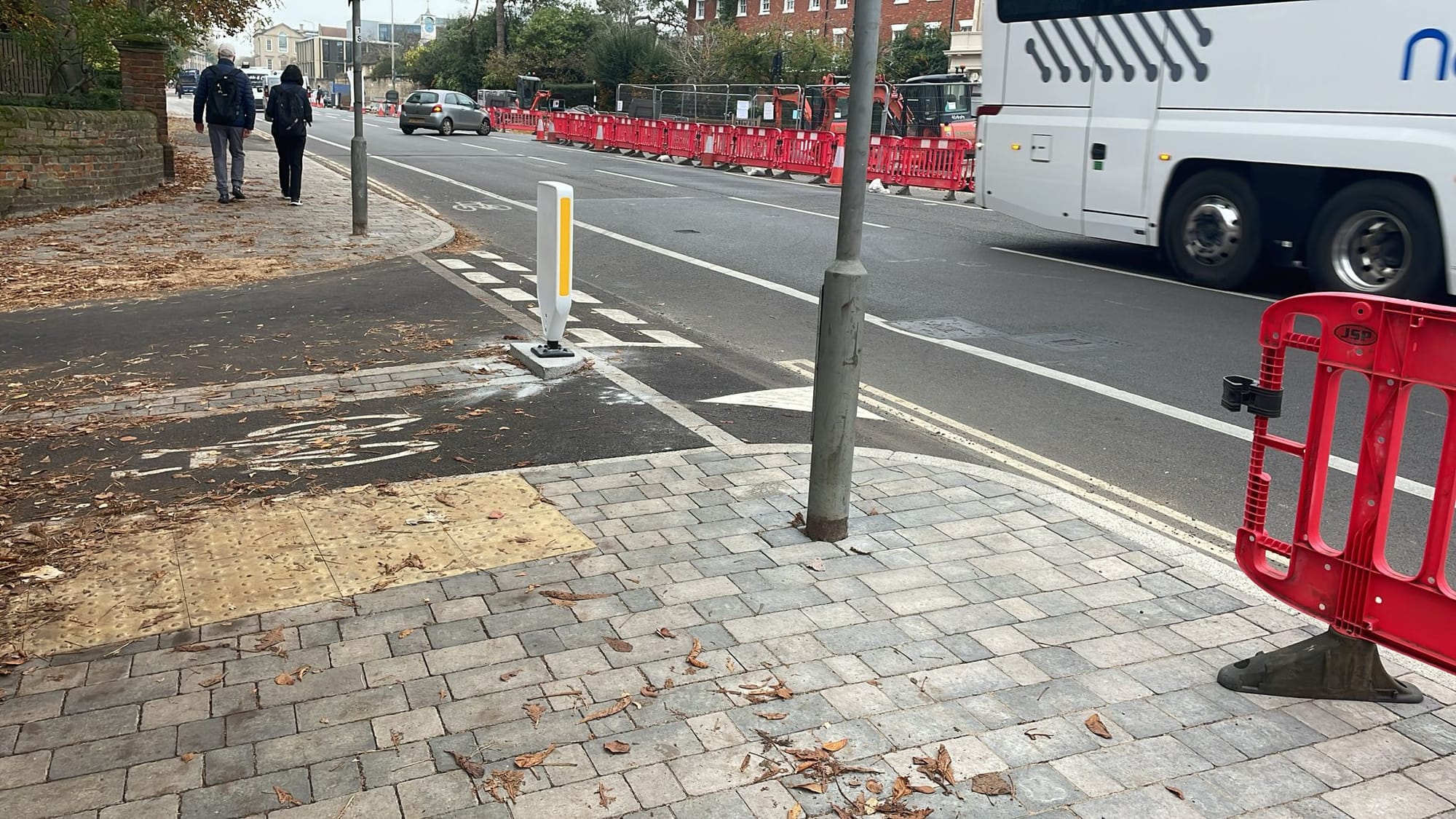
The biggest spend in the £3.2m is a series of “side-road entry treatments”. 11 turnings along Woodstock Road are being improved to “increase pavement space, increase entry ramps and reduce crossing distances for people walking”. This often involves bringing the side-road up to the height of the pavement.
Only one of these (Field House Drive) will be sited where the pavement is shared-use between walkers and cyclists. The other 10 are at locations where the pavement is for walkers only, so cyclists get no benefit from them.
The one unambiguously cycling-focused change is a short extension to the shared-use path from Frenchay Road to St Margaret’s Road. The pavement will be marked out for dual cycling and pedestrian use – essentially, 400m of paint on a pavement. Many cyclists already choose to use the parallel route via Hayfield Road and Jericho at this point, but it will greatly improve safety for children cycling to St Aloysius’ Catholic Primary School.
There is also a series of minor changes, including cats’ eyes along the existing on-road cycle lane, and a new pedestrian/cycle crossing between Observatory Street and Bevington Road.
Will it work?
Oxfordshire County Council has ambitious targets for reducing car use. Its transport plan aims to cut car trips by 25% from 2019 to 2030, and to increase the number of cycle trips from 600,000 a week to 1 million.
It is not on track to hit these targets. Car trips did drop by 2.3% between 2022 and 2024, but to hit the target, the drop needs to be 3.8% each year.
Cycling, meanwhile, is going in reverse. 18.1% of Oxfordshire adults cycled once per week in 2023, down from 20.9% in 2019. Covid complicates the picture in 2020 and 2021, but there has been no discernible uplift since.
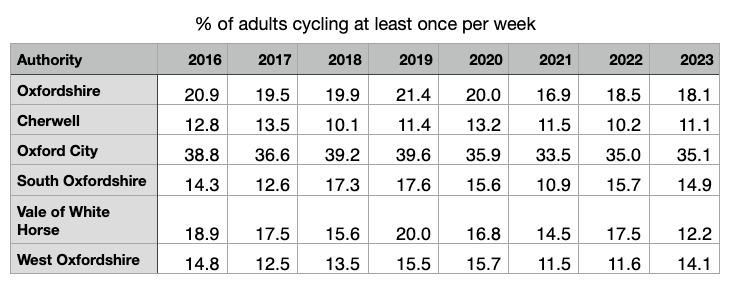
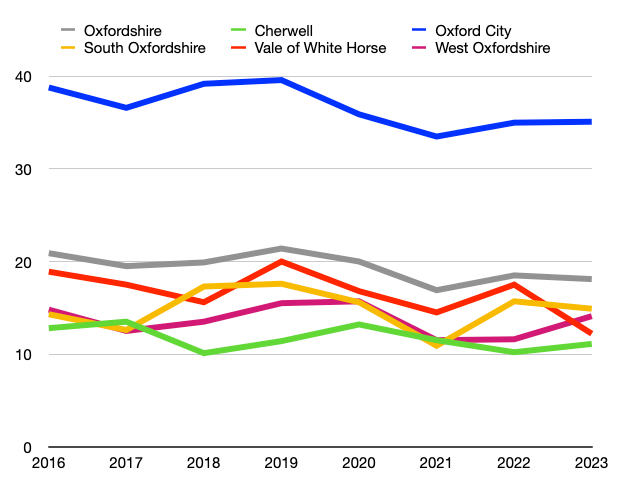
However, data suggests that high-impact interventions can buck this trend. The Low Traffic Neighbourhoods in East Oxford have led to measurable increases in cycling within the LTNs themselves, such as a 78% increase in the number cycling to school at Larkrise. OCC’s monitoring report also reports an increase in cycling after a Bicester scheme was implemented, though there are some questions about the methodology.
Is the Woodstock Road a high-impact intervention of the sort OCC needs to hit its targets? Its own officers seem to admit not by saying “the proposal falls short of long-term aspirations”. Cycling campaigners agree. One told the Clarion:
We’re spending a quarter of the original sum to achieve a twentieth as much. Dropping the speed limit to 20mph and putting in continuous cycling infrastructure would have had a lot more effect.
Side road entry treatments are well down the effectiveness ranking of active travel schemes. The reason they are what all the funding is going on is because they won't upset anyone (especially bus companies) much.
The side-road crossing work will make Woodstock Road more walkable – though less so than the original plans, which would have removed pedestrian/cyclist conflict. But it is hard to see anything in the £3.2m spend that will move the needle for cycling.
What’s the future?

If the £3.2m is unlikely to make a discernible difference in cycling levels or safety, why has Oxfordshire County Council chosen this design above others?
The current statis in Oxford’s cycling infrastructure is partly a result of the delayed traffic filters. Here is how OCC justify the one cycling improvement on Woodstock Road, the 400m extension of shared-use path:
An extension of the shared use, off-road cycle path […] to maintain cycling amenity whilst we assess the outcome of the traffic filter trial
When the filters are introduced, OCC expects peak traffic to drop by 20% across Oxford, and 35% in the city centre. If traffic reduction makes the roads themselves safe for cyclists, the argument goes, there is no need for expensive protected cycle tracks.
A best-case timeline would see Botley Road reopen in December 2025, with the traffic filters trialled for 18 months after that. In other words, OCC will not be able to “assess the outcome”, and decide on future infrastructure, until summer 2027 – six years after the original proposals for Woodstock Road, and only three years before OCC’s 2030 target of increasing cycling levels by 66%. Even if car traffic drops by 20% overnight, this is unlikely to lead to an instant surge in cycling.
There is also significant internal opposition within OCC to building cycle tracks. A presentation given by a senior Active Travel officer, titled ‘LTN 1/20: Panacea or Pipe Dream?’, disagrees with the national policy of building segregated cycle tracks. It contrasts the ‘Oxford approach’ with the ‘LTN 1/20 Dutch approach’, and urges an attitude of “Reclaim the road” rather than “Remove from the road”.
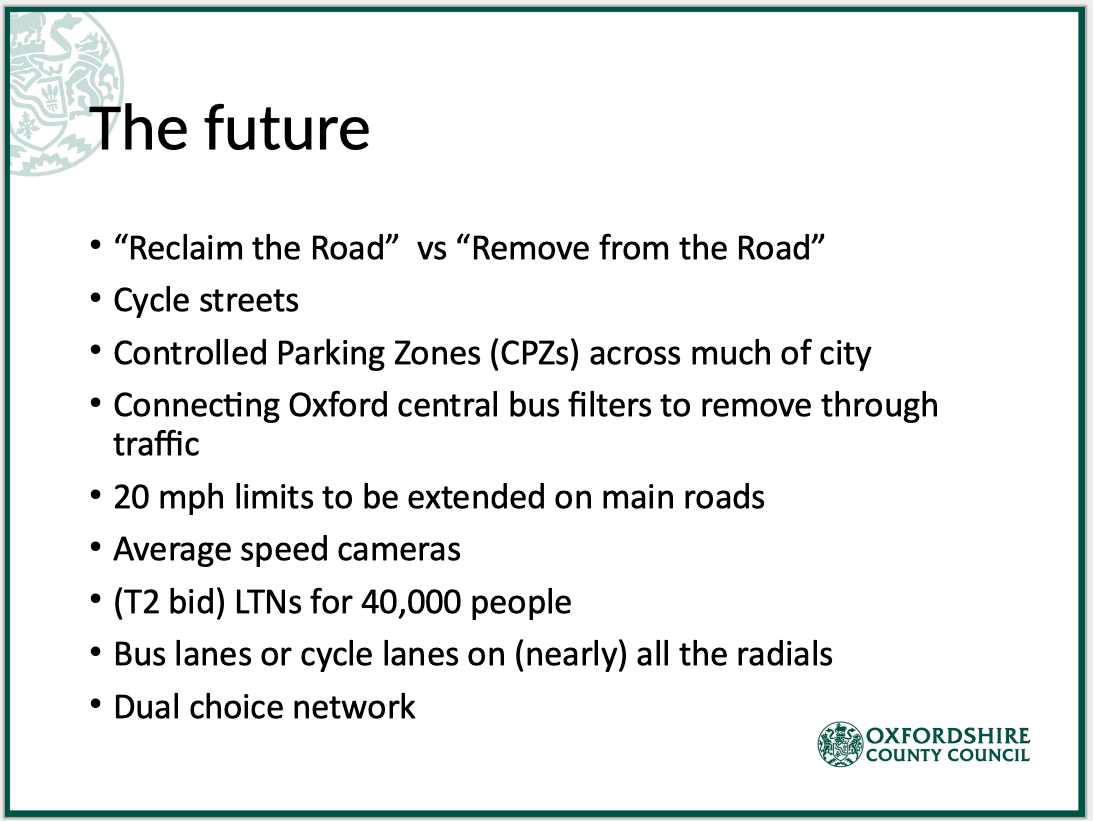
This is not a view universally held within OCC. But with this approach guiding its cycling policy, and with the traffic filters on hold pending decisions about the Botley Road railway bridge, Oxford seems unlikely to gain cycling infrastructure of the level originally proposed for Woodstock Road any time this decade.
Beyond cycling, the Woodstock Road situation raises wider questions about infrastructure spending in Oxfordshire. We reported in May about £278m in developer contributions banked but not spent, and in October about the funding tribulations of the A40 improvements. OCC is now dipping into its pockets to fund another road scheme, the Watlington Relief Road, where Government funding has fallen short. The strict conditions on developer and housing-led funding mean that it’s not as simple as taking money from one pot to pay another, and many of the delays have been outside OCC’s control. But few would argue that Oxfordshire has always managed the process to best effect.
Meanwhile, two years after a report recommended “reallocating the residual funding away from the Woodstock Road Corridor and the Banbury Road Corridor”, a young cyclist is in hospital with life-threatening injuries after a collision on Banbury Road.
A 17-year old cyclist remains in critical condition with life-threatening injuries after yesterday’s hit-and-run collision between a motorcycle and bicycle on Banbury Road. A 51-year old man and 14-year old boy have been arrested. https://t.co/G8AIVLZfOS
— Oxford Clarion (@OxfordClarion) November 5, 2024
Data sources
- Oxfordshire County Council LTCP5 monitoring report
- Department for Transport walking and cycling statistics 2023
Timeline
Taken from Oxford Clarion reports as the story has developed.
- October 2021: Consultation launched on the original scheme.
- March 2022: ‘Co-production partners’ are informed that the project has been paused.
- April 2022: Councillor for Wolvercote, Andrew Gant, writes to electors saying “I have long thought that provision for Active Travel on Woodstock Road is unsatisfactory” and expresses concern at suggestions the scheme could be dropped.
- June 2022: OCC officers recommend “reallocating the residual funding away from the Woodstock Road Corridor and the Banbury Road Corridor”, with funds moved to A40 widening, Benson Relief Road, and Banbury station.
- June 2022: The Future Oxfordshire Partnership scrutiny committee, with representatives from all Oxfordshire’s councils, declines to endorse OCC officers’ plan to axe the project.
- July 2022: Councillors at OCC’s cabinet meeting call dropping the funding “very disappointing”.
- September 2022: Officers produce a draft revised budget that retains Woodstock Road in the budget, but with just £4m allocated.
- October 2022: At OCC cabinet, Cllr John Howson (St Margaret’s) asks why the Woodstock Road budget has been slashed but the “vanity project” of the Oxpens River Bridge is to receive £8m. Andrew Gant adds: “Woodstock Road doesn’t have a joined up cycle track – it doesn’t even reach the primary school.”
- June 2023: In Cabinet papers, OCC officially states that it is no longer progressing the original plan (“the funding to implement that comprehensive scheme is no longer available”) and that it will instead look for “an opportunity to consider some targeted and localised measures to improve cycle and pedestrian facilities in the area”.
- September 2023: OCC signs off plans for the Benson Relief Road, partly funded by money diverted from the original Woodstock Road scheme.
- March 2024: OCC puts the cut-down plans out to consultation, with the budget now further reduced to £3.2m.
- August 2024: Work starts, with the bus lane changes taking place in September, and the side-road entrances between August 2024 and March 2025.
Footnote
2024 is the 50th anniversary of the bus lanes on Woodstock Road. The £3.2m works also include ‘reversing’ a short section of bus lane approaching Wolvercote Roundabout, removing the southbound lane and adding a new northbound lane. The reversal was supported by bus companies but there has been opposition from local residents; a consultation remains live.
